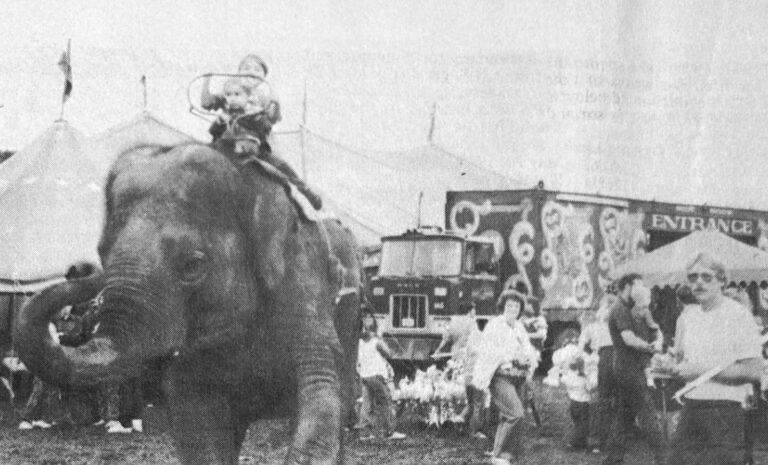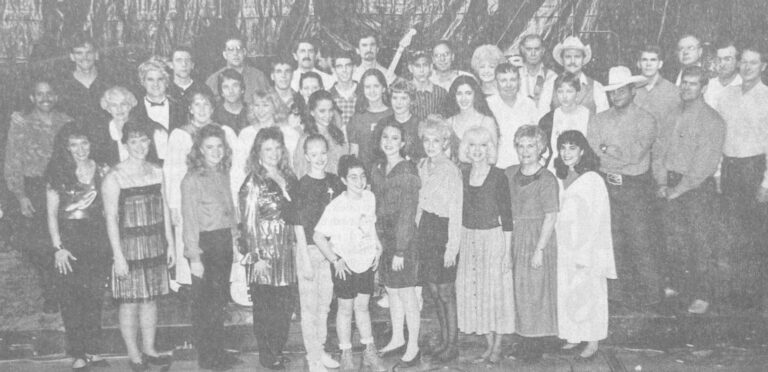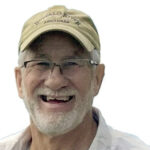Through The Years, Oct. 8

50 years ago
Oct. 15, 1975
— EDMONDSON BUILDING WORK UNDERWAY
Work started Monday on installing a new front to the Edmondson building at Seventh and Main on the public square. The aluminum front will consist of black and white stripes covering the second-floor portion of the building. The spaces are leased by Thompson’s Family Dry-Goods, owned and operated by Mr. and Mrs. Charles Thompson.
— HOSPITAL AND AMBULANCE VOTE IN THREE WEEKS
Incumbent candidates have inked declarations to succeed themselves in November 4 elections for directors of the South Barry County Hospital and South Barry County Ambulance districts. With the deadline for candidates at midnight tonight (Wednesday), officials said directors now holding the posts were the only ones filed. Mrs. Joyce Vaughan, hospital district board secretary, said Jack Byrd of Cassville was the lone candidate for a single post open this year. Byrd has served on the hospital board since it was established. He represents district four. Mrs. Nancy Fare, ambulance district secretary, says incumbents John Gardiner and Bud Barker had announced candidacies to seek second terms. They have been serving on the board since it was established last year. Voters will make choices of the district directorships in balloting on Tuesday, November 4. County Clerk Howard Bounous said polls will be located in the courthouse. Officials of the district said that even though additional candidates might not file before the deadline, ballots presented in three weeks will have space for write-in candidates, as required by Missouri law. Only those voters who were registered as of October 4 will be eligible to cast votes in the coming decision. Holdover directors for the hospital district include Mrs. Ilene Sanders, Bob Oswald, John Sparks and Sheldon Dudley. Rounding out the ambulance district board are these with unexpired terms: Jim Ellis, Paul Yarnall, Lester Purdom and Johnny Ball.
— FALL GOOD GARDEN SOIL TEST TIME
Vegetable gardeners would do well to have their soil analyzed in the fall, according to area horticulture specialist John B. Lower. “In the fall, the gardener and the person preparing the recommendations have the time available,” Lower said. Too many gardeners wait until spring to sample their soil, not realizing that hundreds of others are doing the same. This creates a backlog of samples into the laboratories and causes an abnormal delay. Samples turned in during March and April can be delayed up to four weeks and often are finished too late for the gardener to make the necessary lime or fertilizer applications for that season. Fall sampling helps to even out the load in the laboratory and gets quicker results for everyone. “If we could just get most of the patrons to bring in their samples between September and December it would mean better service for everyone,” Lower said. An appropriate soil sample is made by collecting about 10 slender cores or slices of soil from the surface to a depth of 7 inches, from random areas over the garden. These cores or slices should be crumbled, spread out to dry, mixed thoroughly and one pint of the blended soil submitted to any University of Missouri Extension Center. Under normal circumstances a written report and recommendations will be mailed back.
— SEAMAN NEELY GRAD NAVY SIGNAL SCHOOL
Navy Seaman Apprentice Cary M. Neely, son of Mr. and Mrs. A. V. Blackford of Shell Knob, was graduated from Basic Signalman School at the Naval Training Center, Orlando, Fla. The six-week course includes instruction on the International Morse Code system and on receiving and sending messages by flashing lights, signal flags and other types of semaphore. A 1974 graduate of Maur Hill Preparatory High School, Atchison, Kansas, he joined the Navy in April 1975.
40 years ago
Oct. 16, 1985
— NEOSHO DIOXIN TO COUNTY FOR DESTROY BURN
If all goes well, removal of dioxin-contaminated material from Neosho for incineration at the Denney farm in northern Barry County should begin within the next few weeks, according to Steve Wurtz of the Kansas City office of the Environmental Protection Agency. Wurtz said the incinerator, closed down for maintenance for a while, was started up again last week. The Denney farm is essentially cleaned up, he said, as well as material from the Irwin and Ruscha farms in the general area. The incinerator now is working on cleaning up material from the Talley farm, also in the same area. “In a week or two, we should be ready to transport dioxin-contaminated material from Neosho to the incineration site,” Wurtz said. Material from Neosho to be incinerated includes several steel barrels of contaminated soil and additional soil to be excavated from a contamination site on the former Water and Wastewater Technical School campus. Since incineration started at the Denney farm, Wurtz said, more than 575,000 pounds of soil and 60,000 pounds of liquid have been incinerated. Public hearings by the EPA are scheduled the evening of November 7 in the Barry County courthouse, pertaining to continuation of a permit for operation of the incineration equipment. It is assumed transportation of the materials from Neosho, which result from storage at the WWTS campus, will be along Highway 60, which would carry same through the communities of Granby and Monett. If a Highway 86 route were selected, the wastes could travel through Wheaton, Ridgley, Exeter and Cassville. However, there have been no announcements of travel plans for the contaminated materials. In addition to Neosho’s problem materials, soils in Aurora are also possible projects for the EPA equipment.
— RAIN, WINDS, STILL FALL REVUE SHOWS
Despite a weekend of rain and wind that knocked some foliage off trees, there will be a full Flaming Fall Revue weekend in the Barry County area. This weekend will be the peak, predicted earlier by personnel of Mark Twain National Forest. Observers are hoping for sunshine to add luster to the show. Last weekend’s drizzle, showers and overcast skies gave little brilliance to the color display. Rainfall in the area through the weekend measured from 2.5 to 3.5 inches, depending on locations. Thundershowers were heavy in some areas, but there was no flooding reported. While a number of trees shed their entire supply of leaves in rain and winds Sunday, U.S. Forest Service people and those at Roaring River State Park said this weekend, if sunny, will be a brilliant show of fall colors.
30 years ago
Oct. 11, 1995
— SECLUSION OF LAKE AREA CHALLENGES LAW EFFORTS
Remoteness accentuates the beauty of Shell Knob and the Barry County lake area. These communities, located along the shores of Table Rock, can be accessed by winding roads that ribbon through the Mark Twain National Forest. The tranquil setting attracts retirees as well as families looking for a wholesome place to raise their children. Strange as it seems, the same attributes that make Shell Knob an attractive place to live also make law enforcement efforts more difficult. Reaching most places in the Shell Knob area requires travel on extremely curvy roads. Thick vegetation offers cover not only for deer and other animals ready to spring in front of a fast-moving patrol car but also helps hide signs of crime and those trying to evade the law. Table Rock Lake prohibits a direct line of travel. One must drive “around” the lake to get to certain locations, adding precious minutes to officer response time. In addition, the Shell Knob community straddles Stone and Barry County lines, complicating jurisdictional definition. Since Shell Knob is not incorporated, it has no city government or police force. Residents must rely on the Missouri Highway Patrol, the Water Patrol and the Barry and Stone County Sheriff’s offices for law enforcement needs. All of these agencies work together. However, the Water Patrol usually attends to matters related to lake supervision, and the Highway Patrol’s primary concern is highway safety and automobile accidents. Response to complaints and criminal investigations are directed by the two sheriffs’ offices. With Shell Knob being approximately 17 miles from Cassville and 25 miles from Galena where the sheriffs’ offices are located, response time is slow because of the distance officers must travel. As the population of Shell Knob and surrounding areas has grown, so has crime. Both Stone and Barry Counties report increases in the number of calls over last year. According to Stone County Sheriff Lonnie Mease and Barry County Sheriff Ralph Hendrix, most complaints from the Shell Knob community fall into the categories of burglaries and domestic disturbances. Both blame the large number of burglaries on the need for drug money and contend that the majority of domestic disturbances involve excessive alcohol consumption. Specific crime statistics for the Shell Knob area were not available from either county. Both sheriffs claim that violent crime is not a problem in the Shell Knob area. This article is the first installment in a threepart series about crime in the Shell Knob area. The next two articles will deal with challenges facing law enforcement officers and alternatives for dealing with increasing crime.
— RENOVATION OF LOCAL HOME UNCOVERS CASSVILLE HISTORY
Renovating an older house is a painstaking process. One of the first steps for many renovators is researching the home’s history. During a search for historical information, Larry and Kathy Robison of Cassville uncovered some interesting glimpses into the past when they began reading the abstract on their newly purchased home. The Robisons bought one of the remaining older homes in Cassville. The Victorian-style house sits on the corner of Gravel and First Streets. The abstract the Robisons received when they bought the house did not include a date when the home was built. After conferring with local historians, it was determined that the home was built around 1900 by Thomas Simpson (“Simp”) Frost. The abstract includes pages of entries that date back before the 1900s. One of the earliest entries in the abstract was a warranty deed dated March 29, 1851, whereby William Kerr and his wife, Martha, sold their acreage to Littleberry Mason. The land description included references to a “double white oak stump near Thompson E. Mason’s residence” and a fence passing south of the jail. The next entry in the abstract is the last will and testament of Littleberry Mason. In his will, Mason left everything, including mansion house, out houses, stables, corn cribs and farming utensils, to his wife, Nancy. At the time of his death, Mason’s farm stock was worth $500. He left $150 to each of his five younger children, John Christopher, Sarah Jane, William James, Littleberry Newsom and George M. Dallas. Mason also left $20 to be divided between the heirs of his deceased daughter, Julia Ann Vaughan. The will also included references to slave ownership. “I further direct that my said wife Nancy have and retain the following negroes, viz: Washington, Henry, Hannah and her two children, and Susan, to keep them on the farm for her own use during her life or widowhood, and my negro man Bill, to be hired out, in such manner as my executors shall think most advisable.” Mason’s will was witnessed by Miller Lee and Isaac Crow. A. B. Greenway was judge at that time, and Michael Horine served as recorder. In the early 1870s, Mason’s heirs sold their parcels of land to Dr. P. Pharis, the husband of Mason’s daughter, Columbia. One of Mason’s sons, John Christopher, was declared insane. This information and court proceedings were also included in the abstract. In 1892, the Pharises sold a portion of their land to T. S. Frost. It was between that time and the time of his death in 1937 that Frost is believed to have built the home now owned by the Robisons. Upon his death, Frost’s property was inherited by his daughter, Maud Reynolds, and his son, Claud Frost. G. E. Truhitte, P. E. Horine and H. M. Allen witnessed the will, and it was certified by Probate Judge D. B. Meador. In 1939, Claud and Leota Frost sold their portion of the property to Reynolds. Royle Ellis served as the notary public on the warranty deed dated January 14, 1939. In 1946, Reynolds sold part of her property to Earl and Thelma Coley. The Coleys then sold lots to J. C. and Bessie Hutchens in 1950 and to Loyce and Edna Boswell in 1954. The property has exchanged hands several more times since the 1950s. It has been owned by M. G. and Ruth Montgomery, Herbert and Vivian Dann, and Jerry and Sharon Ford. Several other names from Cassville history dot the yellowing pages of the aging abstract. They include: W. G. Townsend, justice of the peace in 1847; G. W. House, probate judge in 1867; Mabel Messer, deputy recorder in 1893; and John P. Ray, publisher of the Cassville Democrat in 1937. The Robisons plan to keep a portion of Cassville history intact by repairing and restoring the home they purchased on Aug. 24. They have re-sided the home and are now working on the interior rooms. “I have wanted this house since I was a child,” said Kathy. “And now I’ve got it.” Kathy is the daughter of Mr. and Mrs. Paul McNabb of Exeter.







